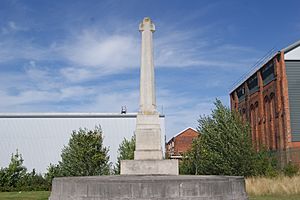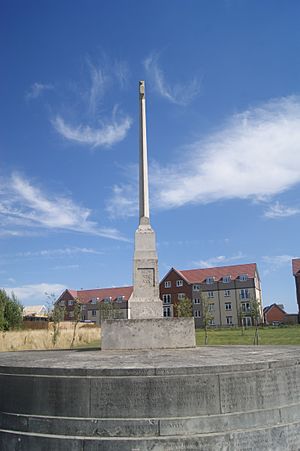British Thomson-Houston Company War Memorial facts for kids
Quick facts for kids British Thomson-Houston Company War Memorial |
|
|---|---|
| United Kingdom | |
 |
|
| For workers from the British Thomson-Houston Company killed in the First World War | |
| Unveiled | 1921 |
| Location | 52°22′58″N 1°15′18″W / 52.382745°N 1.255124°W Technology Drive, Rugby, Warwickshire
|
| Designed by | Sir Edwin Lutyens |
|
IN MEMORY OF THE MEN OF THE BRITISH THOMSON-HOUSTON COY WHO GAVE THEIR LIVES IN THE GREAT WARS
|
|
|
Listed Building – Grade II
|
|
| Official name | British Thomson-Houston Company War Memorial |
| Designated | 13 June 2007 |
| Reference no. | 1392027 |
The British Thomson-Houston Company War Memorial is a special monument in Rugby, Warwickshire, England. It was built to remember the workers from the British Thomson-Houston Company who went to fight in the First World War and sadly died. A famous architect named Sir Edwin Lutyens designed it. The memorial was officially revealed in 1921. Today, it is a very important historical site, known as a grade II* listed building.
Contents
Remembering the Wars
After the First World War, many memorials were built across Britain. This was because so many people lost their lives. One of the most famous designers of these memorials was Sir Edwin Lutyens. He was known as a top English architect of his time.
Lutyens also designed other important memorials, like The Cenotaph in London. This monument is where people gather every year for Remembrance Sunday. He also created the Thiepval Memorial to the Missing, which is the biggest British war memorial in the world. The Thomson-Houston Company memorial is one of 15 "War Crosses" that Lutyens designed. They all look quite similar.
The British Thomson-Houston Company
The British Thomson-Houston Company was an engineering business located in Rugby. During the First World War, their factory in Rugby made important parts for the Royal Navy. This included things like radio and signaling equipment.
The memorial was first made to honor 243 company employees who died in the First World War. Later, it was also dedicated to 175 employees who died in the Second World War.
This memorial is one of only six that Lutyens designed for private companies. Other large ones include memorials for the Midland Railway and North Eastern Railway.
Building the Memorial
The leaders of the British Thomson-Houston Company decided to build a memorial in April 1921. They asked their chairman to take charge of the project. The memorial was officially opened on October 29, 1921. A military leader, Field Marshal Sir William Robertson, unveiled it. A local building company, J Parnell & Son Ltd, built the memorial. They even buried a time capsule under it! This capsule held information about the company and its war records. The whole project cost about £3,243 in 1921.
Design Details
The British Thomson-Houston Company War Memorial follows Lutyens' special "War Cross" design. It is a tall cross, about 7.3 meters (24 feet) high. It is made from a type of stone called Portland stone. The cross has short arms near the top of its main shaft, which gets narrower towards the top.
The cross stands on a base made of four square steps. Below that is a square stone block, called a plinth. This plinth then sits on a larger round base, about 7.5 meters (25 feet) wide. This round base makes it a bit different from other Lutyens memorials.
The main message on the memorial says: "IN MEMORY OF THE MEN OF THE BRITISH THOMSON-HOUSTON COY WHO GAVE THEIR LIVES IN THE GREAT WARS". The dates of the two world wars are written on either side. Below that, it says: "THEIR NAME LIVETH FOR EVERMORE". The names of all the people who died are carved onto the round base.
Moving the Memorial
When it was first built, the memorial was at the entrance of the British Thomson-Houston factory. In 2010, the area was redeveloped. So, the memorial was moved about 400 meters (1,300 feet) away. It is now on Technology Drive, where the company's electrical engineering works used to be.
The memorial was first recognized as a grade II listed building on June 13, 2007. This means it's an important historic structure. In October 2015, during the 100-year anniversary of the First World War, Lutyens' war memorials were given special recognition. The British Thomson-Houston Company War Memorial was then upgraded to a grade II* listed building. This means it is even more important historically.


